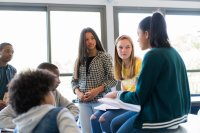Catching Lightning in a Bottle
If you know your students well, adapting your lessons around a current event that interests them may be the right move.
Your content has been saved!
Go to My Saved Content.Sometimes the best thing to do with a thoughtful, well-designed lesson plan is throw it out the window on a whim.
That’s I do when my students show interest in a current event. Last spring my ninth graders read a movie review of Black Panther, and it sparked a discussion far more rich and insightful than I expected.
My students’ interest, coupled with the movie’s record-breaking opening weekend, inspired me to find more ways to incorporate it into my instruction. So my student teacher and I threw together a field trip application to take our kids to see it. We were about to start Homer’s Odyssey, so the film would make for an interesting comparison of archetypes.
My principal approved the trip immediately. We created an online fundraiser to help drive down student costs. When I shared the fundraiser with my colleagues, other teachers wanted to take their students, too. We raised $1,100 in 10 days and took 107 students to see the film.
The next day in class, kids couldn’t say enough about T’Challa’s conflicts—both his physical struggle to keep his throne and his moral struggle to decide between preserving Wakanda’s resources or sharing them with the rest of the world. They debated Killmonger’s role as both a villain and a hero, noting that he needed mentors like the ones T’Challa had. They also pointed out that despite his hatred and violence, he did want to help others.
They likened Shuri to Mercutio, Shakespeare’s “jester” archetype in Romeo and Juliet, but also labeled her a “hero” for saving T’Challa and halting Wakanda’s civil war, and a “wizard” because she designed Black Panther’s vehicles, suits, and weapons. They quoted the movie and asked questions about tribal symbols. The comic book fanatics in the room critiqued its humor and action sequences.
The discussion stayed with them while they wrote movie reviews of their own and explored the Hero’s Journey in the days that followed. What had begun as a simple example of persuasive writing turned into a field trip and a weeks-long exploration.
Black Panther was just one example of catching lightning in a bottle. In previous semesters I had made time to take a deeper look at “Gangnam Style,” corporal punishment in public schools, affluenza, and Oscar Pistorius. It’s a different experience each time, but I’ve learned strategies over the years that help me take advantage of these moments and build new units on the fly.
How to Catch Lightning in a Bottle
1. Know your students. Improvisation only works if you listen to and learn from what your students give you. Create an environment in which they feel comfortable expressing themselves and listening to one another. Elicit their feedback and learn where their passions lie.
One week before students returned to school this fall, protesters toppled Silent Sam, a Confederate monument on the University of North Carolina’s campus. It sparked protests and debate throughout my community, and I wanted to use it in class as a way to explore race, the First Amendment, and American history. But I needed time to first get to know my students, gauge their interests, and establish a respectful classroom culture, so I held off.
2. Know your curriculum. The better you understand your state’s curriculum standards, the easier it is to find ways to incorporate students’ interests. If a comprehensive set of plans is already in place, topics that resonate with students can become opportunities to improve a lesson’s breadth and depth.
Two years ago, my students couldn’t stop talking about the adaptation of Jay Asher’s 13 Reasons Why on Netflix, so we read an article about the show and wrote cause-and-effect essays. The assignment met North Carolina’s standards for writing and literacy, but students were so engaged that I invited guidance counselors to join class discussions, and made the book an option during a literature circle unit later in the semester. These adjustments helped cover speaking, listening, and literature standards, too.
3. Be realistic. It isn’t always possible to scrap a month of lesson plans just because students respond well to something new. Instead, try making the smallest adjustment necessary to enhance students’ learning experience, then reflect on how it went and decide if you can and should do more.
Authors Chip and Dan Heath call this technique ooching. In Decisive: How to Make Better Choices in Life and Work, they explain how to construct small experiments to test a hypothesis before going all-in. “The ultimate reality-testing is to ooch,” they write, “to take our options for a spin before we commit.” Teachers who are strapped for time or loyal to their traditional plans can still improvise. Take small steps before reinventing the wheel.
4. Open your door. When students surprise you, tell your colleagues. It may foster collaboration and lead to integrated studies and cross-curricular experiences. When I shared my students’ interest in Black Panther, two other teachers jumped on board. Together we designed opportunities to compare and contrast hero characters in British literature and American comic books, to analyze African American representation in film, and to consider how representation fosters or destroys stereotypes.
When planning instruction, winging it isn’t the right approach. But abandoning a lesson plan, if done thoughtfully when the right opportunity presents itself, can create dynamic, personalized experiences that students will never forget.
